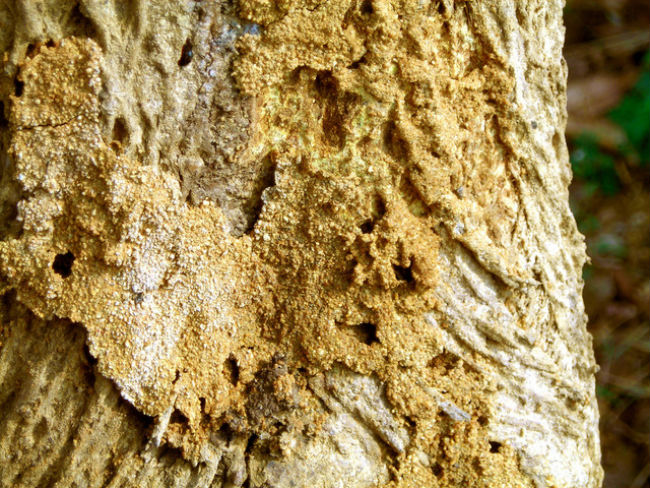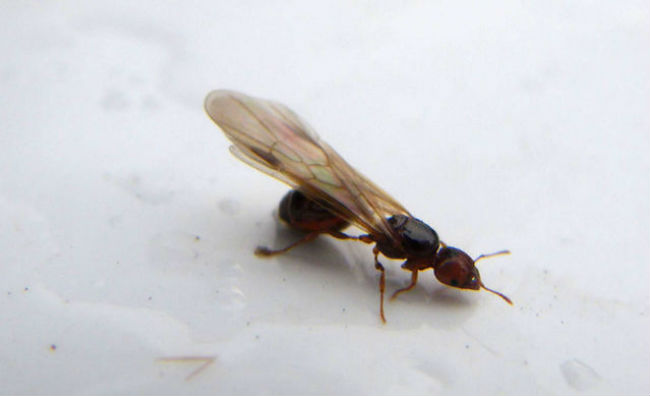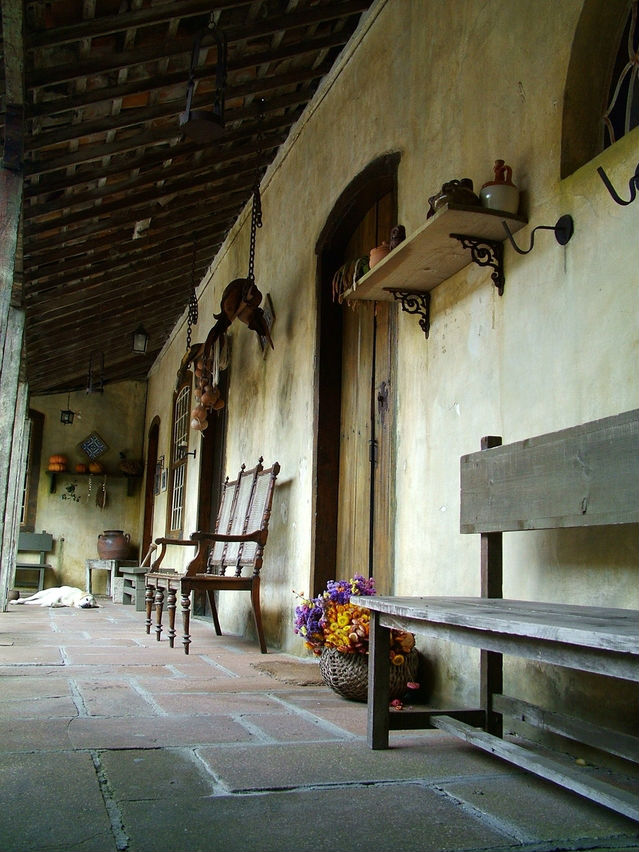There are different drywood termite types or species in the USA. Among them the most common and widely-spread are Western Drywood Termites (light and dark), Light Southeastern Drywood Termites, West Indian Drywood Termites. These wood pests consume wooden products of all types, cause serious damage to building constructions, woodworks and furniture. You can easily distinguish a drywood termite from subterranean and dampwood due to the place of their life activity.

Western Drywood Termites
Western Drywood Termite (Incisitermes minor) belongs to Kalotermitidae family. They prefer nesting and living in warm conditions. They occupy a vast territory from South Carolina westward to Texas and upward the West Coast of California.
Flying dark western drywood termites have narrow 0.5 inch long bodies of orange-brown color with dark brown abdomen. Their 4 wings are of the same size, long and dark. Winged mating cycle season occurs during hot sunny days all the year round. The most intensive period when you can observe winged drywood termites swarming is in fall from September till November. Soldiers are smaller and only 0.3 inch long. They have bright reddish brown head, very unusual club-like antennae, whitish eyespots and large jaws. Dark western drywood termite is the most hazardous and destructive wood pest among all drywood termites types in the USA. It can be observed in the area from Utah and Arizona westward to California.
Light western drywood termites (Marginitermes hubbardi) are typically found in the south of the USA (esp. in California and Arizona) and in Mexico. Winged light western drywood termites have narrow about ½ inch long bodies of creamy color. Their wings are light. Swarming season is at dusk during hot sunny days from late spring to early fall. Light western termite soldiers are about 0.2-0.3 inch long. They have large light-orange head with whitish eyespots, narrow body of creamy color, very uncommon antennae with club-like third segment and enlarged mandibles (jaws).
Light Southeastern Drywood Termites
Light Southeastern Drywood Termite (Incisitermes snyderi) is widely distributed in the southeastern regions of the USA. They were easily transported with contaminated wooden products. Nowadays they can be observed in US states from South Carolina to Texas, in the eastern islands as the Bahamas. They do not live in large colonies.

Light southeastern drywood mature termites are 0.5 inches long, narrow, cylindrical in body. They are light-brown or tan in color. Swarming season is rather long from late spring to early fall. Drywood termite swarmers can look like flying ants, but the main difference is that termites have long transparent two pair wings of equal size and shape, which they discard after landing. The shed wings are about 0.4 inches long.
West Indian Drywood Termites
West Indian Drywood Termite (Cryptotermes) were spread worldwide at those times when infested goods from India were brought by wooden ships. In America this dry wood termite type was first found in the early 20th century in Florida and Key West, then they were observed in tropical regions, in Hawaii, Florida and in the southeast coastal areas of the USA.
West Indian Drywood Termite soldiers and alates are narrow, cylindrically-bodied and medium-brown or tan in color. Winged reproductives are formed about three-four weeks before mating or swarming cycle. They are about 0,4 inches in length including the wings. Alates have two pairs of long hairless equally-sized and -shaped wings. The shed after landing wings are about 0,3 inches long. Drywood termite alates are weak fliers so they cannot move on long distances. West Indian termite loose its wings soon after finding the place for starting a new drywood termite colony.
West Indian Drywood Termite swarming season lasts about several weeks starting from April till June. In tropical and southern regions it occurs earlier, even from late February. You can also occasionally observe flying drywood termites during warm and sunny days in the fall.
Subterranean and Drywood termites: differences and pecularities
Drywood Termite is a less spread type in the USA to compare with Subterranean termite species. Drywood termite colony includes approx. 10,000 zooids, which is far less than subterranean colonies, containing approx. 500,000 individuals. Drywood termites also need wood as the source of food and energy and as the place for living. They prefer dry wood and timber with low humidity level as termites of this type have an adaptive mechanism to the lack of moisture. For this reason, they can overcome difficulties and survive for long periods of time without water.
Drywood termites do not build common muddy termite mounds and termite nests in the ground. They do not need the soil for this purpose as subterraneans do. They occupy dry wood and make excavations inside – they are called the nest chambers. Drywood termites have shorter legs than subterranean’s and it means they move and spread more slowly.
Drywood Termite Types at home: evidence, prevention, treatment
During mating season all types of drywood termites can fly into your home and infest woodworks such as frames, cabinets and headboards. Drywood termite evidence is the appearance of pellets piles on the floor and near cracks and holes in the wooden structures. Termite droppings resemble rice grains in shape, they are very small, browny depending on the color of wood consumed.

In order to prevent drywood termite types invasions, you can follow our advice: never keep firewood and timber close to your house; regularly check up the furniture, woodworks for drywood termite infestation signs; regularly plug up small holes, crevices, cracks in wood structure and foundation; repair air vents in time and apply chemicals for wood treatment or termite resisting wood for building structures.
Drywood termite types treatment or extermination can be performed in the following ways:
1. spot drywood termite types treatment with chemicals or naturally by professional exterminator
2. local drywood termite treatment yourself with chemicals or naturally
3. structural fumigation by professional pest exterminator
4. local fumigation of infested wood materials by professional pest control company
We recommend you to call for a pest specialist in order to eradicate drywood termite types.
Leave a Reply